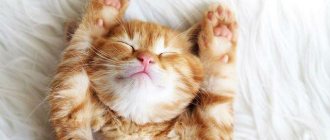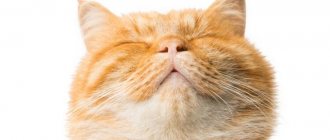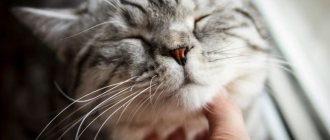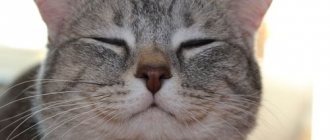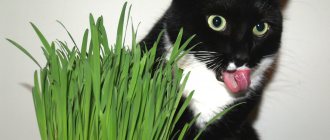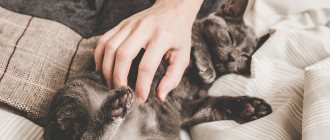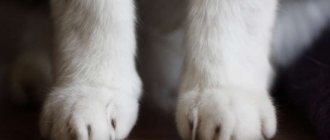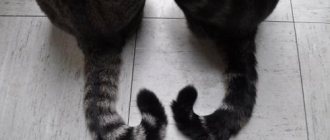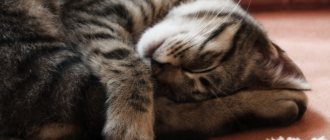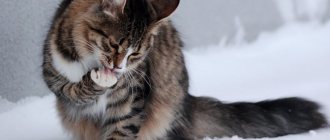The purring of a cat is one of the most pleasant sounds for an animal owner. But the mechanism of origin and its properties still remain a mystery. Even felinologists cannot say exactly when cats learned to purr. It seems that the hoarse vibrating sound relates exclusively to the expression of emotions, but this is not so.
Let's find out what a cat purrs about and how to react to this behavior of a pet.
What is purring and who, besides a cat, makes it?
It is believed that a cat's purring calms both the pet and others. Although objectively this acoustic vibration can also be an alarming signal.
Not only domestic cats purr, but also some inhabitants of the wild world:
- Gorillas, elephants and squirrels can rumble. The desire to express pleasure sometimes appears during food.
- Hyenas, foxes and bears with badgers also periodically grumble and make a sound similar to the purring of a cat.
- A team of predators (from lynx to tiger) is “carried away” by purring singing.
A person hears all this motley “company” only in the zoo from a safe distance, but the sounds of cats at any volume level can be fully enjoyed at home.
If we formulate it without emotional connotation, then purring cats produce a vibrating sound of varying duration in a predominantly low tonal register.
Although there is some gradation in the cat’s vocal roulades, it relates more to the place and circumstances - the cat’s purring changes even depending on the mood of its owner, on whose lap it is located.
This is interesting! Even musicians who can imitate the voice of any animal have not been able to create with their instruments a sound similar to the way cats purr next to a person.
Where does the sound come from?
These sounds, which people call “purrs,” are produced by pets through the larynx. A cat has vocal cords that, although different from human ones, work on the same principle. That is, purring is not an arbitrary, but a well-thought-out process. The animal's brain sends an impulse to the larynx, and the cat makes purring sounds. An interesting fact is that with its mouth closed, a cat can only make vowel sounds, and to make consonants, its mouth must be opened. Therefore, it is easy to conclude that the sounds that a cat makes when it lies calmly on its knees and the sounds that it makes when playing with a bow are different.
Mechanism of purring (vocal cords, diaphragm, vascular theory)
One of the options for the formation of unusual sounds that representatives of the cat family make relates to the work of the respiratory organs, muscles in the larynx and vocal cords.
Studies using an electromyograph (a device for studying bioelectrical muscle potentials) have shown the mechanism of a cat's purring to be the use of vocal folds or laryngeal muscles. By rapidly alternating expansion and contraction of the sound passage, they cause rhythmic continuous vibrations of air in the inhalation-exhalation cycle.
It is in this cycle that the characteristic rumbling of a cat is born. The hypothesis does not illustrate all the features of the occurrence of noise, and therefore remains one of the puzzles in a puzzle that has not yet been solved.
Another failed discovery is the launch of the mechanism through the lungs and diaphragm. Observers came to this conclusion when they compared the cat’s purring and its breathing pattern. But they were never able to explain the entire line of behavior, from managing desire to its implementation.
Blood pressure was also not forgotten. They checked how it circulates through the vessels and even suggested the presence of hemodynamic processes - purring is formed as blood moves through the chest. No irrefutable evidence has been found, but at the level of rumors, this hypothesis is being discussed among cat lovers.
The next point of serious research is the hyoid bones and the degree of their hardening. It was noticed that animals cannot both purr and growl at the same time. Therefore, purring cats were enrolled in one group, and roaring cats in the other.
A characteristic feature of the first (including domestic ones) is a completely ossified ligament of the hyoid bones, while in representatives of the second group this property is partially expressed. The exception is the snow leopard. He can purr, like a cat next to a person, but his hyoid bones are not hard.
The most reliable option explaining purring is neurophysiological. A neural network oscillator was discovered in a cat's brain. This phenomenon is complex and even in humans has not been fully studied. Its job is to cause brain waves, which cause the nervous tissue to generate oscillatory activity. These impulses seem to control the hyoid bones, and they, in turn, cause the vocal cords to vibrate.
This is interesting! Cats purr with both their nose and mouth at the same time. At the same time, the body resonates so much that it is impossible to listen to the work of the heart or lungs.
Therapeutic purring as one of the tools of feline therapy
Even in those days when the benefits of cats purring were not officially recognized, the first attempts were made to use purring for treatment. Today there is no doubt that a cat's purring has a therapeutic effect. Many owners say that only thanks to their pet, they stopped suffering from insomnia and began to relax (let go of stress). Treatment topics are actively discussed on cat fancier forums, with owners writing about their pet being treated for a wide variety of conditions. Particularly striking are the facts that four-legged animals relieve their owners from migraines, problems with blood pressure and acute pain due to arthritis.
Note! Even experienced cat owners rarely notice that their pet purrs differently. This happens because the cat almost always purrs the same way to the owner (human), with a frequency of 25 Hz.
Felinotherapy is a little popular, but actively gaining momentum, method of treating people with the help of cats. It’s interesting, but doctors of traditional medicine started talking about using purrs in therapy. The assumption about the healing purring and company of cats was put forward after a long period of work in clinics and rehabilitation centers that used non-traditional methods of therapy. The most striking indicators were recorded in clinics working with special children and people who suffer from mental disorders.
In some strange way, patients with a serious degree of wariness either did not pay attention to the cats or made contact with them. The patients themselves explained their positive emotions by the fact that cats behave naturally, not intrusively, and can calm and “warm the soul.” Today, according to official recommendations, feline therapy is indicated for patients suffering from panic attacks and obsessive states.
Observations have shown that a cat can find an approach to an autistic child and even a patient suffering from obsessive schizophrenia.
By the way, dogs also work in this area. Before taking up their post, dogs undergo training for a period of 2–3 years, while cats undergo conditional selection and do not need training.
Over time, the healing abilities of cats have been found to help patients with heart disease, brain damage and severe addictions. American doctors have come to the conclusion that the purring of a cat and the very presence of the animal promotes tissue regeneration and restoration and strengthening of bones.
The main reasons for a cat's purring
The most common causes of cat purring are:
- The animal purrs when asking for food.
- Demonstrates mood (joy, boredom, gratitude, etc.).
- Cats purr when they want to attract their owner's attention.
- It is believed that even fear stimulates the appearance of a vibrating purr.
- Pain relief and relaxation, for example, a cat may make a purring sound during labor.
Little kittens purr literally from the moment they are born. Sometimes this skill comes to them later, and some do not master the “vocal” art until the end of their days. But the presence or absence of this quality depends on the breed and other individual reasons.
What are the benefits of purring?
There are opinions that purring has benefits and has a positive effect on the human body. The main ones are:
- soft sound with a special timbre, frequency 27-44 Hz, has a healing effect on the body;
- purring has a positive effect on the health and condition of bones;
- has a calming effect on a person;
- helps get rid of stress and relieve fatigue after work;
- sound vibrations affect human brain activity and help normalize blood pressure;
- a massage can be compared to an acupuncture session.
Some of these misconceptions have no scientific basis and are simple myths that have taken root in society. Having a cat in the house can have a positive impact on a child's development. According to statistics, children who had animals in childhood treat them better.
If a child has contact with a cat before the age of three, the allergens form a strong immunity to allergies. There are other statistics. People who have pets at home live on average 4-5 years longer than those who do not have pets.
Why do cats purr next to a person (when you pet them, they crush them with their claws and lie on their owners)
The gift of healing ailments belongs to the most mysterious section of the cat encyclopedia. The point, apparently, is in the frequency of sounds made and not only in them.
- Cats purr in the range of 20 to 150 hertz (Hz), a very comfortable tonal range that does not cause negative emotional aversion.
- Purring calms and helps to relax - if the cat is comfortable, then the owner has nothing to worry about.
- Often, cats lie on their owners and, when petted, start a quiet, monotonous “song.” Felinologists believe that the vibration of their body and the low sound of purring (20-50 Hz) have a beneficial effect on the condition of bones and joints. And higher tones can heal skin and muscle tissue.
- It has been noticed that animals “feel” injured areas on the human body - the cat purrs, lies down on the sore spot, and after a while the owner feels better.
Most likely, cats purr and lie on their owners, thanks to the natural instinct to settle in the warmest place. Inflamed areas of the body have an increased temperature, so the pet chooses them instinctively.
Even traditional stomping (with or without claws) can be considered a massage, but scientists attribute this ability to a genetic memory of preparing a den for sleep.
How to determine by purring what a cat wants
The meaning of a cat's purring depends on the animal's mood and health.
- He rubs against his legs, purrs and arches his back - he greets and attracts attention.
- It rumbles as soon as the owner is in the kitchen, next to food - he wants to eat.
- She settled down next to the owner somewhere on the sofa, purred, demanding affection.
- It bends over, stomps in one place and purrs endlessly - probably the animal is in pain.
- The unreasonable purring of a cat that is resting means that it has found a comfortable place for itself.
Cat massage
There are many guesses why the pet purrs and tramples its owner with its paws. Here are some of them:
- Memories of childhood, or “milk step” - kittens knead their mother with their paws while feeding to quickly obtain milk. This brings them pleasure and is associated in adults with a feeling of comfort, satiety and security.
- Prepares a comfortable place to sleep - tramples the surface on which you are going to sleep for the greatest comfort. The owner's knees may well be suitable for this purpose.
- Gratitude - in this way one can say “thank you” for delicious food, warm shelter, tenderness and affection.
- Therapeutic massage is a common theory that this is how a cat treats its owner from ailments.
- Stress relief – by purring and moving their paws, cats lift their spirits, relax and calm down.
- Unfulfilled sexual instinct - one theory says that if an animal does not have a mate, it may show unambiguous interest.
- Marks its property - cats have glands on their paw pads that secrete a secretion. This is one of the ways to convey to other animals that a person belongs to him.
- Showing trust and love - the pet shows its owner its location, favor, openness and trust. Emphasizes your closeness with a person.
What to do if your cat doesn't purr
Arbitrary options for the appearance or absence of “musical” abilities in cats are possible:
- Volume. Some cats purr in a barely audible voice.
- Genetics. The English Devon Rex does not purr itself, and does not teach its children to do so.
- Mood. A purring cat can remain silent for a long time. The reasons are different - from resentment towards the owner to jealousy towards others.
Vibration and sound, typically signifying the purring of a cat, is an optional sign of mood, breed or attitude towards a person.
The most purring breeds
Until now, no pattern has been identified that explains the desire of cats to purr. Owners are inclined to the theory of sociability - the more sociable the animal, the more talkative it is. This means that the cat that purrs is one that wants to spend time with its owner. Pedigree and street cats have equal chances here.
As for the volume level, its maximum is 20 decibels, which is quite comfortable for human hearing. For comparison, street noise is 2.5 times louder.
This is interesting! The mongrel cat Smokey from England became famous for her outstanding purring - she purred 68 dB, was included in the Guinness Directory, and at the same time forced her owner to move away from her neighbors.
